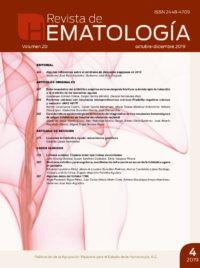Cuban patients with classic Philadelphia-negative chronic myeloproliferative neoplasms and JAK2 V617F mutation.
Rev Hematol Mex. 2019 octubre-diciembre;20(4):255-261. https://doi.org/10.24245/rhematol.v20i4.3139
Karina Casanueva-Calero,1 Gissel García-Menéndez,1 María Teresa Martínez-Echevarría,1 Milania Díaz-López,1 Nadezhda González-García,1 José Carnot-Uria2
1 Laboratorio de Genética Molecular.
2 Servicio de Hematología.
Hospital Clínico Quirúrgico Hermanos Ameijeiras, La Habana, Cuba.
Resumen
ANTECEDENTES: La mutación JAK2V617F constituye un marcador importante para definir la existencia de una neoplasia mieloproliferativa Filadelfia negativa clásica.
OBJETIVO: Evaluar la frecuencia de la mutación JAK2V617F en pacientes cubanos con neoplasias mieloproliferativas Filadelfia negativas clásicas.
MATERIAL Y MÉTODO: Estudio transversal descriptivo que de 2012 a 2018 incluyó pacientes con neoplasias mieloproliferativas Filadelfia negativas clásicas remitidos del servicio de Hematología del Hospital Clínico Quirúrgico Hermanos Ameijeiras, en Cuba. La detección de la mutación se realizó mediante la técnica de PCR alelo-específico en el Laboratorio de Genética Molecular de esa institución.
RESULTADOS: De los 95 pacientes estudiados, 56 (58.9%) resultaron positivos a la mutación y 39 (41.1%) negativos. La mayor frecuencia se encontró en los pacientes con policitemia vera (n = 33.7%), seguida de la trombocitemia esencial (n = 22; 46.8%) y la mielofibrosis primaria (n = 1; 25%). La asociación entre las frecuencias de la mutación y las enfermedades clínicas fueron significativas (p = 0.009). El mayor porcentaje de pacientes con la mutación correspondió a la población masculina (n = 30, 53.6%), al color de la piel blanco (n = 40, 71.4%) y a los de 50 años de edad o más.
CONCLUSIONES: La frecuencia de la mutación JAK2V617F en pacientes cubanos con policitemia vera, trombocitemia esencial y mielofibrosis primaria corresponde con la reportada en estudios similares en otros escenarios poblacionales.
PALABRAS CLAVE: Mutación; neoplasias mieloproliferativas crónicas; reacción en cadena de la polimerasa; PCR.
Abstract
BACKGROUND: The mutation JAK2V617F constitutes an important marker to define the presence of a classic Philadelphia-negative myeloproliferative neoplasia.
OBJECTIVE: To evaluate the frequency of the mutation JAK2V617F in Cuban patients with classic Philadelphia-negative myeloproliferative neoplasms.
MATERIAL AND METHOD: A descriptive cross-sectional study was carried out from 2012 to 2018 including patients with classic Philadelphia-negative myeloproliferative neoplasms referred from the Hematology service of the Clinical and Surgical Hospital Hermanos Ameijeiras, Cuba. The detection of the mutation was carried out using an allele-specific PCR technique at the Laboratory for Molecular Genetics of this institution.
RESULTS: Of 95 studied patients, 56 (58.9%) were positive to the mutation and 39 (41.1%) negatives. The highest frequency was found in patients with polycythemia vera (n = 33, 75%), followed by those with essential thrombocythemia (n = 22; 46.8%) and primary myelofibrosis (n = 1; 25%). The association between the frequencies of the mutation and the clinical diseases was significant (p = 0.009). The greatest percentage of patients with the mutation corresponded to males (n = 30; 53.6%), to the patients with white color of the skin (n = 40; 71.4%) and to those aged 50 years or more.
CONCLUSIONS: The frequency of the mutation JAK2V617F in Cuban patients with polycythemia vera, essential thrombocythemia or primary myelofibrosis correlates with those reported in similar studies in other population scenarios.
KEYWORDS: Mutation; Chronic myeloproliferative neoplasms; Polymerase chain reaction; PCR.

